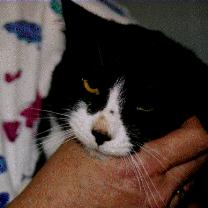Avenal State Prison Reverts to Its Old Aulirophobic Ways by Scrapping a TNR Program and Cutting Off the Cats' Food Supply

It is not part of the national agenda but at the local level there are only a handful of more contentious issues than homeless cats and, in particular, Trap, Neuter, and Return (TNR). Generally speaking, the battle lines are usually drawn with advocates of extermination, such as animal control officers, shelter operators, bird advocates, and wildlife proponents, on the one side and proponents of sterilized colonies on the opposing side.
With the notable exception of rural communities where they often find employment as mousers on farms and ranches (See Cat Defender post of February 21, 2006 entitled "Chairman Meow Finds a Home in a Barn and a Job as a Mouser on Texas Horse Ranch"), homeless cats are personae non gratae almost everywhere else.
Even though they are purposefully dumped there by uncaring students, they are certainly not welcome on college campuses (See Cat Defender posts of June 14, 2006 and September 11, 2006 entitled, respectively, "Kindhearted Dairyman, Sacked for Feeding Feral Cats, Files $20 Million Lawsuit Against Cornell University" and "Selfish and Brutal Eggheads at Central Michigan University Target Colony of Feral Cats for Defamation and Eradication") nor on military bases. The corporate world is hostile to them (See Cat Defender post of July 27, 2006 entitled "Northrop Grumann Plans to Exterminate a Colony of Feral Cats That Has Lived at Its Redondo Beach Facility for Twenty Years") as is the public sector (See Cat Defender post of October 20, 2005 entitled "After Ridding Ohio Statehouse of Rats, Cats Now Find Themselves Facing Eviction").
Private clubs do not want them (See Cat Defender post of January 19, 2006 entitled "Public Outcry Forces Army Navy Country Club to Scrap Plans to Exterminate Long-Term Resident Felines") and they are not even safe in abandoned buildings (See Cat Defender post of March 31, 2006 entitled "Idaho Humane Society Lends Its Support to the Demolition of a Derelict Seed Store That Claims the Lives of Dozens of Cats"). They are even denied safe harbor on beaches (See Cat Defender post of September 25, 2006 entitled "Photographer Captures the Beauty of Feral Cats That New Jersey Coastal Town is Hellbent on Exterminating") and faraway islands (See Cat Defender post of September 21, 2006 entitled "Aussies' Mass Extermination of Cats Opens the Door for Mice and Rabbits to Wreak Havoc on Macquarie").

Now comes word that they have worn out their welcome at Avenal State Prison (See photo above) even though hundreds of them have shared the grounds of the sprawling six-hundred-forty-acre facility with one-thousand employees and seventy-five-hundred medium-security inmates since it opened in January of 1987. In particular, a TNR program inaugurated in 2001 by the prison and outside volunteers was abruptly discontinued in February of this year allegedly because of its cost and ineffectiveness.
Under the original agreement, the cats were humanely trapped, desexed, and vaccinated. The adults were returned to the prison to work as mousers and to keep the inmates company while new homes were found for the kittens.
"It's good for the inmates. Its' good for rodent control," Joyce Bicknell (See photo above of her and Boo Boo), a retired employee of the California Feline Foundation who now works with Feral Paws Rescue, told The Fresno Bee on September 25th. (See "Prison Cat Program Declawed; Fur Flies.") "It's a perfect environment for them," she added in reference to the isolated, treeless, sun-baked lockup located eighty-nine kilometers south of Fresno at the foot of Kettleman Hills in Kings County.
James Haley, a spokesman for warden Kathy Mendoza-Powers (See mug shot below) gave several reasons for scrapping the initiative, known as the Star Project, and not surprisingly a lack of staff and money were at the top of his list. "Do you want your tax dollars spent on cats or do you want tax dollars spent on inmates?" he rhetorically asked The Fresno Bee in the article cited supra.

That charge was quickly rebutted by Bicknell who told the newspaper that not only was ample funding available through grants and donations but that veterinarians were also willing to provide their services either gratis or at reduced rates. In the past, Maddie's Fund has footed the bill for the sterilizations.
Haley also argued that the program was stopped because it was ineffective in controlling the feline population. In order to buttress his claim, he pointed out that only four out of one-hundred-fifty cats trapped during the last four to five months that the program was in place had been previously sterilized.
This assertion has also been rejected by Bicknell and her allies who claim that the colony, which originally numbered around six-hundred cats, has been reduced by between one-hundred and two-hundred cats through TNR. Alley Cat Allies, however, claims on its website that only about two-hundred cats remain out of an original population of five-hundred. Needless to say, without accurate before and after statistical data there is not any way to evaluate these conflicting claims.
The apparent ineffectiveness of the program could be attributable to there being more cats than previously inventoried or perhaps it is simply a matter of more time and effort being needed before the program bears fruit. Since the compound is surrounded by an electric fence that is sandwiched in between a double cyclone barrier topped with concertina wire, it is unlikely that any newcomers have gotten in to join the colony.

Although the point is moot as far as Avenal is concerned, TNR should not be judged solely by its efficacy in keeping out other feral cats. TNR eliminates the ability of sterilized cats to reproduce and that in and of itself reduces feline overpopulation. The fact that new cats may join a colony only means that trapping and sterilization must be an ongoing process. More importantly, homeless cats, like down-and-out individuals, must have somewhere to hang their hats.
More than likely TNR's death knell at Avenal was sounded in August of 2005 when the California Division of Occupational Safety and Health (OSHA) fined the prison $2,500 for three violations relating to its care of the cats. The report in The Fresno Bee does not specify the nature of these infractions but most likely they were related to safety and health concerns.
Cal OSHA's Dean Fryer told The Fresno Bee that the prison's TNR program was "not fully instituted or evaluated to be effective." He did not recommend, however, that it be abandoned, only that better controls were needed. Nonetheless, prison officials used this criticism and fine as the pretext for discontinuing TNR.
Tant pis, Avenal has also removed the eight to ten feeding stations inside the compound as the result of Cal OSHA's damning report. The report in The Fresno Bee does not broach the subject of what the cats are doing for sustenance nowadays but Haley callously dismissed such mundane concerns by saying, "These are feral cats... they're used to being on their own."

The dismantlement of the feeding stations has led to another disagreement between the contending parties with prison officials claiming that starving the cats to death has helped to reduce their population whereas cat advocates have countered by arguing that the number of cats is actually increasing.
Following the discontinuance of TNR, prison officials and the volunteers entered into an informal compact whereby the prison agreed to trap the cats and hold them until they are picked up by the volunteers. So far, however, this arrangement is not working out.
First of all, prison officials are not trapping very many felines and, secondly, they are turning over to Avenal Animal Control those few that they do snare if volunteers do not collect them before 4 p.m. Due to a lack of space at their shelter, Animal Control leaves the cats in their traps on its lawn until the volunteers collect them.

This has led to some cats being imprisoned in traps for as long as forty-eight hours without either food or water. Because of either their extended confinement or rough handling, many of these cats have been injured as the result of their ordeal. (See photo above of a bloody cat in a cage.)
The Fresno Bee does not delve into what happens to these cats but presumably the kittens are put up for adoption. The fate of the adults is a good deal more problematic. If they are not exterminated by either Animal Control or the prison, the volunteers must either socialize them and find new homes for them or find somewhere else to release them.
Several instances of feline cruelty have also been uncovered by Alley Cat Allies and the Star Project. For instance, a black cat (See photo above on the left) and her five kittens were recently discovered secured with duct tape inside a trash can. When rescuers finally arrived some eight hours later one kitten was near death.
In a shocking act of desecration that demonstrates not only the warden's contempt for cats but also her total lack of respect for the departed, a feline cemetery, meticulously maintained by the inmates, was ordered destroyed on March 28th of this year. (See photos above and below.)

The remains of more than one-hundred cats interred there were removed, wrapped in trash bags, and placed inside a box. Even Alley Cat Allies has been unable to determine what officials have done with them; more than likely they were tossed out with the garbage.
Malheursement, the recent events at Avenal mark a return to the prison's old atavistic, aulirophobic ways. Most notably, in November of 2002 prison officials deliberately sealed up alive about thirty-five cats underneath one of the buildings inside the compound. This barbaric act led to the deaths of more than two-dozen cats by starvation and dehydration. Rescuers were able to save a cat named Inmate (See photo below) and several others but most of the trapped cats died horrible deaths as their mummified remains vividly demonstrate. (See photo below.)
The California Department of Corrections and Rehabilitation (CDCR) does not have a comprehensive policy on dealing with cats and other animals that turn up at its institutions and consequently each facility is free to deal with them as it sees fit so long as it does so in a humane manner. Humane treatment, however, means different things to different people. For instance, most cat-haters consider extermination to be humane.
It is not known how widespread TNR programs are within the American penal system, but in addition to California they are also being tried at institutions in New York and Montana.
A world away in Cape Town, authorities recently announced that they are planning to transfer the feral cats who have been living on the grounds of Parliament to dreadful, maximum-security Pollsmoor Prison. (See The Pretoria News, September 15, 2006, "Parliament's 'Fat Cats' Off to Jail.")

While this is no doubt an ominous turn of events for the felines, it is nonetheless a big improvement over the South Africans' extermination campaigns at Nelson Mandela's old gulag on Robben Island. (See Cat Defender posts of March 23, 2006 and April 27, 2006 entitled, respectively, "South Africans, Supported by Ailurophobic PETA, Are Slaughtering More Cats on Robben Island" and "Cat-Hating Monster Les Underhill and Moneygrubbing Robben Island Museum Resume Slaughtering Cats in South Africa.")
Elsewhere in California, the Solano County Sheriff's Claybank Sentenced Detention Center, located sixty-two kilometers west of San Francisco, and the Blaine Street jail in Santa Cruz have instituted successful programs whereby female inmates serve as surrogate mothers to feral kittens. (See Cat Defender post of October 27, 2005 entitled "Inmates at Women's Prisons in California Save Lives by Fostering Feral Kittens.")
Under these innovative programs, the kittens have someone to care for them until they are old enough to be adopted while the inmates learn parenting skills, earn certificates of achievement, and receive reductions in their sentences. Most importantly, the program saves lives. It is a win-win situation for all concerned.
Contrary to the defamation campaign launched by officials at Avenal, most of the felines that Bicknell and others have had examined by veterinarians are healthy. Also, not all of them are feral.

Their presence has also had a humanizing effect on both staff and inmates. Over the years, caring employees have fed and watered the cats, bottle-fed kittens, and even smuggled out newborns. In addition to burying the cats and tending to their graves, inmates have also fed and helped to care for them. Some of them have even adopted cats.
For instance, Miss Samples, an eight-year-old black and white cat, was at one time the pet of lifer Louis Vigel (See photos below). "I call her Samples because once we had a lot of grasshoppers in here and she went around biting them in half, sampling them," he told The San Francisco Chronicle on September 9, 2001. (See "A Death Sentence Handed Down to a Prison Colony of Feral Felines Is Commuted to Life -- and Sterilization.")
It is not known if either Vigel or Miss Samples are still at Avenal but according to The Fresno Bee Miss Samples is definitely still alive.
The situation at Avenal is not ideal for the cats. As is the case with the inmates, there is no escape for them. Some of them also no doubt die horrible deaths by electrification on the high-voltage fence that surrounds the compound. This fence also claims a number of birds each year but yet the inveterate cat-haters at the National Audubon Society and the American Bird Conservancy are not calling for the heads of prison officials as they so often do for any cats caught dining on birds.

Also, since all of the cats are either black, gray, or black and white inbreeding may potentially cause genetic concerns down the road. These difficulties pale in comparison, however, to the ailurophobic behavior of prison officials which needs to be drastically amended.
Nonetheless, these cats need a place to live. The prison needs low-cost rodent control and the inmates and staff need feline companionship. Despite Haley's assertions, the care and maintenance of the cats does not cost the institution a cent; besides, with an annual budget of $98 million even the $2,500 fine from Cal OSHA is a drop in the bucket.
More to the point, Avenal has a moral responsibility to the cats. Because of its airtight security, the cats did not simply wander onto the grounds; au contraire, they were unquestionably brought in by prison officials to control the rodent population. The fact that they have multiplied so prolifically is the fault of the prison for not having instituted TNR a long time ago. For instance, between the prison's opening in 1987 and the introduction of TNR in 2001 the only feline population control practiced at Avenal was sporadic extermination.
Even though Avenal created the problem, Feral Paws Rescue and Alley Cat Allies are willing to correct the situation at no cost to the prison. Instead of thanking and cooperating with these dedicated animal welfare groups, prison officials have obstructed their efforts and reverted to their old barbaric ways.

The petit fait that the inmates at Avenal have enough compassion and bon sens to care for the cats whereas prison officials are capable of only denigrating and exterminating them presents a prima facie case that this nation needs to take a good hard look at exactly who it is that it is incarcerating.
America has more than two million individuals behind bars and this number is growing by eighty-three-thousand per month. Most of these individuals are either drug users or petty thieves who do not belong in the can; they need treatment and jobs that pay a living wage. As long as the prison-industrial complex is permitted to flourish, however, the jails will always be overflowing in this country. America has tons of money to spend locking up people in either jails or homeless shelters but not a sou for affordable housing, good jobs, or low-cost health care.
The scarce space at Avenal could be better utilized by the incarceration of inveterate cat-haters and abusers such as Mendoza-Powers. This space could also be used to house war criminals such as Bush and Olmert, crooked politicians, thieving capitalists, and polluters.
Photos:Kim Komenich of the San Francisco Chronicle (inmates with cat, Miss Samples with Louis Vigil, and Miss Samples by herself), The Fresno Bee (Joyce Bicknell and Boo Boo), CDCR (Kathy Mendoza-Powers), Avenal Prison Cat Rescue (injured cat in trap, Inmate, and mummified cats), Alley Cat Allies (black cat that survived trash can ordeal and feline graveyard).

<< Home